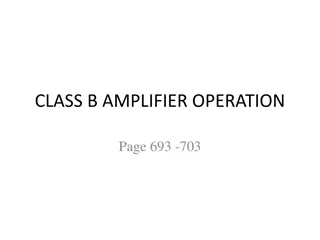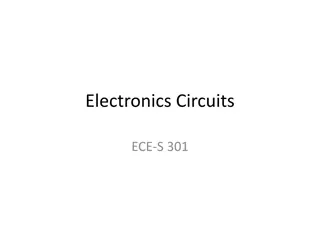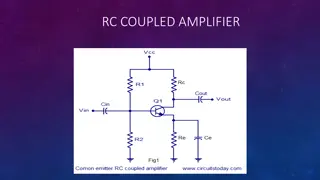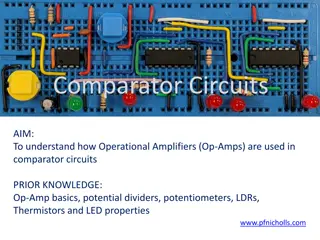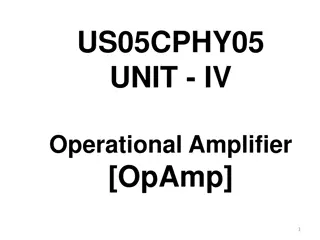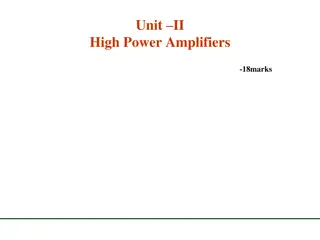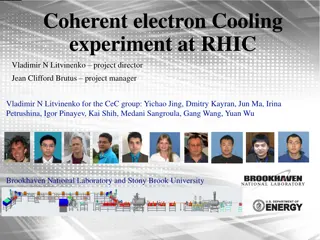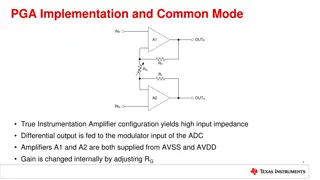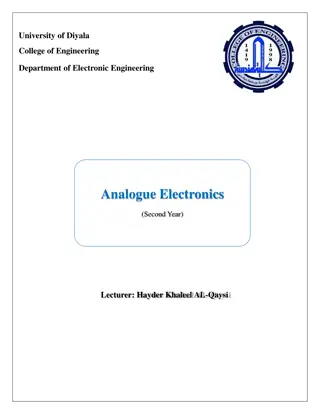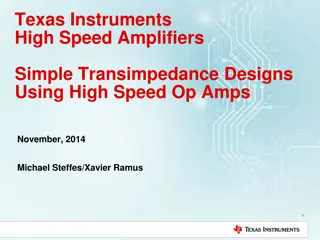Understanding Operational Amplifiers and Their Applications
An operational amplifier (op-amp) is an essential electronic component that amplifies signals and performs mathematical operations like addition and differentiation. Originally developed in the 1940s, op-amps have evolved from vacuum tube technology to modern integrated circuits (ICs). They are widely used in various applications due to their versatility, low cost, and ease of production.
- Operational Amplifiers
- Electronic Circuits
- Integrated Circuits
- Signal Amplification
- Analog Electronics
Download Presentation

Please find below an Image/Link to download the presentation.
The content on the website is provided AS IS for your information and personal use only. It may not be sold, licensed, or shared on other websites without obtaining consent from the author. Download presentation by click this link. If you encounter any issues during the download, it is possible that the publisher has removed the file from their server.
E N D
Presentation Transcript
OPERATIONAL OPERATIONAL AMPLIFIER AMPLIFIER Dr DrAriya Ariya Saraswathy Saraswathy Assistant Professor Assistant Professor Department of Physics Department of Physics V T M NSS College V T M NSS College Thiruvananthapuram Thiruvananthapuram
AMPLIFIER AMPLIFIER It is an electronic circuit or device which increases the amplitude of a signal
OPERATIONAL AMPLIFIER OPERATIONAL AMPLIFIER (O (OP PA AMP MP) ) Historically an Op Amp was designed to perform such mathematical operations as addition, subtraction, differentiation. Hence the name Operational Amplifier. integration and
Background Originally invented in early 1940s using vacuum tube technology Initial purpose was to execute math operations in analog electronic calculating machines Shrunk in size with invention of transistor Most now made on integrated circuit (IC) Huge variety of applications, low cost, and ease of mass production make them extremely popular
ICs ICs
Fairchild Semiconductors National Semiconductors A 702 (1963) A 709 (1965) A 741 (1968) A 748 (1968) LM101 (1967) LM101A (1968) LM107 (1968) LM324 (1974)
741 Op 741 Op- -Amp Amp Internal Circuitry Internal Circuitry
OP AMP A MULTISTAGE AMPLIFIER Differential Amplifier stage High gain CE amplifier stage Class B push pull emitter follower Class B Push pull Amplifier Differential Amplifier More stages of gain
Ideal Op Amp Ideal Op Amp Practical Op Amp Practical Op Amp Zin = Zout = 0 AV = Zin = 2M Zout = 100 AV = 105
Voltage Transfer Characteristic Range where we operate the op amp as an amplifier. V Vin in
APPLICATIONS APPLICATIONS
Op-Amp Differential Amplifier If R1 = R2 and Rf = Rg:
Op-Amp Integrator Vo = -
Low-pass Filter (active) Cutoff frequency This works because the capacitor needs time to charge.
Applications of Op-Amps Electrocardiogram (EKG) Amplification Need to measure difference in voltage from lead 1 and lead 2 60 Hz interference from electrical equipment
Simple EKG circuit Uses differential amplifier to cancel common mode signal differential mode signal and amplify Realistic EKG circuit Uses amplifiers to first amplify voltage from each lead, followed by differential amplifier Forms an instrumentation amplifier two non-inverting
Strain Gauge Use a Wheatstone bridge to determine the strain of an element by measuring the change in resistance of a strain gauge (No strain) Balanced Bridge R #1 R #1 = = R #2 R #2 (Strain) Unbalanced Bridge R #1 R #1 R R #2
Half-Bridge Arrangement Op amp used to amplify output from strain gauge R + R Rf Vref R + Vcc + - + - + - Vcc R V0 R - R __ Rf Using KCL at the inverting and non-inverting terminals of the op amp we find that ~ Vo = 2 R(Rf /R2)
Op Amps Applications Audio amplifiers Speakers and microphone circuits in cell phones, computers, mpg players, boom boxes, etc. Instrumentation amplifiers Biomedical systems including heart monitors and oxygen sensors. Power amplifiers Analog computers Combination of integrators, differentiators, summing amplifiers, and multipliers
THANK YOU







